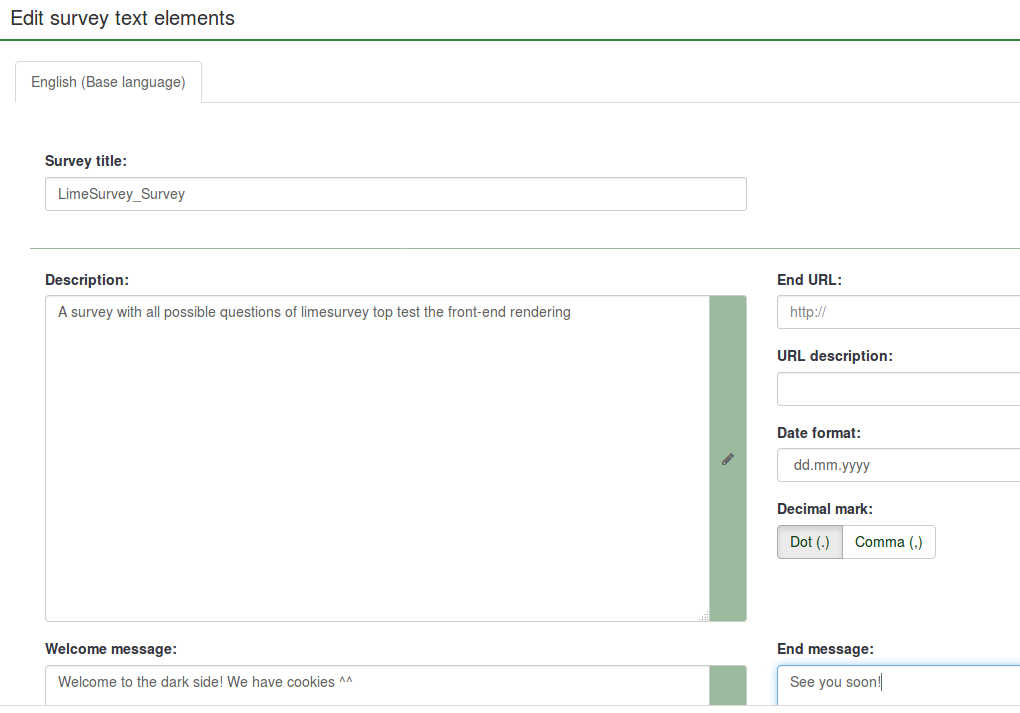Text elements: Difference between revisions
From LimeSurvey Manual
No edit summary |
No edit summary |
||
| Line 2: | Line 2: | ||
<translate> | <translate> | ||
__TOC__ | |||
=Introduction= | |||
From the [[Survey texts#Survey texts|Survey texts panel]], you can edit the title of the survey and its description, welcome and end messages, end URL of your survey, and the format of the decimal mark and date. | |||
=Survey texts= | |||
The following fields are located in this panel: | |||
<center>[[File:Settings Menu - Survey texts.png]]</center> | |||
*'''Survey title:''' The title of the survey can be changed from this field; | |||
*'''Description:''' | *'''Description:''' You can type in a survey description. If enabled from the [[Global settings|global settings]], use the [[Global_settings#General|HTML editor]] to better customize the description field; | ||
*'''End URL:''' You have the possibility to redirect users to another page when they finish filling in the questionnaire. If you wish to redirect them, type in the URL and activate the '''automatically load URL''' option that is located under the [[Surveys - introduction#Presentation & navigation|Presentation & navigation tab]]; | *'''End URL:''' You have the possibility to redirect users to another page when they finish filling in the questionnaire. If you wish to redirect them, type in the URL and activate the '''automatically load URL''' option that is located under the [[Surveys - introduction#Presentation & navigation|Presentation & navigation tab]]; | ||
Revision as of 18:45, 19 October 2017
Introduction
From the Survey texts panel, you can edit the title of the survey and its description, welcome and end messages, end URL of your survey, and the format of the decimal mark and date.
Survey texts
The following fields are located in this panel:

- Survey title: The title of the survey can be changed from this field;
- Description: You can type in a survey description. If enabled from the global settings, use the HTML editor to better customize the description field;
- End URL: You have the possibility to redirect users to another page when they finish filling in the questionnaire. If you wish to redirect them, type in the URL and activate the automatically load URL option that is located under the Presentation & navigation tab;
- URL description: A short end URL description can be added in the case in which the user is redirected to a non-related survey webpage. It may help the survey administrator to add notes vis-a-vis the usage of the respective URL;
- Date format: This option is important when you want to record timestamps together with the survey participants' answers. If you click on it, a drop-down list will show up with a multitude of date formats. Choose the one that fits your survey respondents. Do not forget that different date formats are used across the world. For example, it is recommended to use a different time format if your questionnaire focuses on the US market (mm-dd-yyyy) and not on the British market (dd-mm-yy);
- Decimal mark: Two options are available: dot (.) and comma (,). Choose the one that fits the place where you conduct your study (e.g. US vs Germany);
- Welcome message: Type in a message that will welcome the survey participants when they access your survey link;
- End message: Type in a message that will be displayed to the survey participants once they finish the questionnaire. If the end URL field is automatically loaded, the end message is not displayed anymore.
If you use more languages for your survey, each language will have a corresponding tab on the languages toolbar (they will be displayed after the base language).